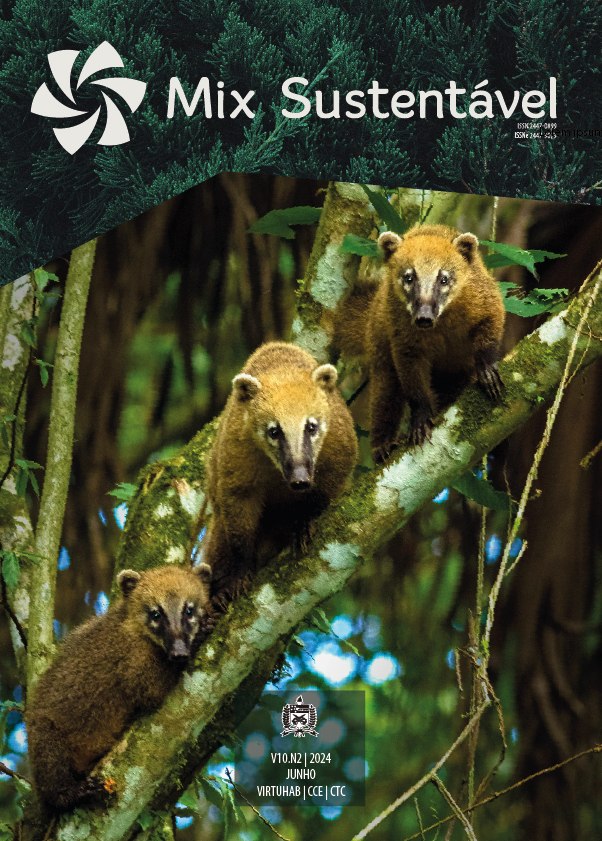CULTURA, HISTORIA, MATERIALES NATURALES EN ANGOLA: ARQUITECTURA VERNÁCULA Y LAS POSIBILIDADES PARA UNA CONSTRUCCIÓN MÁS SOSTENIBLE
CULTURE, HISTORY, NATURAL MATERIALS IN ANGOLA: VERNACULAR ARCHITECTURE AND THE POSSIBILITIES FOR MORE SUSTAINABLE CONSTRUCTION
DOI:
https://doi.org/10.29183/2447-3073.MIX2024.v10.n2.219-231Palabras clave:
Sostenibilidad, Materiales naturales, Arquitectura vernácula, Técnicas constructivas, AngolaResumen
Este artículo se centra en la arquitectura vernácula angoleña y forma parte de una disertación de maestría. Como
herencia y patrimonio cultural, comprender la arquitectura vernácula también nos ayuda en la búsqueda de alternativas
de construcción más sostenibles. De esta manera, este artículo buscó caracterizar la arquitectura vernácula angoleña
mediante una revisión bibliográfica teórica y un estudio de caso en la provincia de Huíla (localidad de Mupalala),
Angola, para las cabañas de la etnia Nyaneka-Humbi. Para el estudio de caso, fue necesario entrevistar a los residentes
locales para comprender los aspectos culturales de la construcción, las técnicas constructivas y los materiales
empleados. Finalmente, fue posible caracterizar este tipo de construcción y entender posibles contribuciones para la
proposición de una construcción más sostenible.
Citas
AA.VV. 1993, Vernacular Architecture: ICOMOS International Committee on Vernacular Architecture, International Scientific Committee, 10th General Assembly, Central Cultural Fund, Sri Lanka.
ALEXANDRE, L. Luanda, da arquitetura vernácula ao Séc. XXI. 2016. Dissertação de Mestrado em Arquitetura. Universidade Lusófona de Humanidades e Tecnologias: Departamento de Arquitetura. Disponível em: < https://core.ac.uk/download/
pdf/84897822.pdf>
ANNA-MARIA, Vissilia. Evaluation of a sustainable Greek vernacular settlement and its landscape: Architectural typology and building physics. Building and Environment, v. 44, n. 6, p. 1095-1106, 2009.
BAPTISTA, Júlio L.; RIBEIRO, Jorge T. Tecnologia vernacular vs. tecnologia global: desenvolvimento de uma metodologia de projeto. Vernacular Technology vs. Global Technology: Development of a Project Methodology. Lisboa, LNEC: Laboratório Nacional de Engenharia Civil, p. 322, 2013.
BARBACCI, Norma. Arquitectura Vernácula: concepto, ejemplos y revaloración. Revista Científica De Arquitectura Y Urbanismo, v. 43, n. 2, p. 65-71, 2022. Disponível em: < https://rau.cujae.edu.cu/index.php/revistaau/article/download/685/636>
BAŞARAN, Tahsin. Thermal analysis of the domed vernacular houses of Harran, Turkey. Indoor and Built Environment, v. 20, n. 5, p. 543-554, 201.
BENGUELA. Residência evolutiva do tipo T1 e as suas respectivas fases. Documentação do projeto. 2014.
CALEI, Grongel; BENGUELA, Francisco. Urbanização da Quissala, casas evolutivas no município do Huambo, província do Huambo, Angola. DW
HabiTerra S. A. 2016.
DANIEL, Alberto Fuma Jivala, Arquitetura Tradicional em Angola- Estratégias de Sustentabilidade. Instituto Técnico de Lisboa; 2019.misra Disponível em: <https://arqpar.pt» arquitectura_sustetável_angola.> . Acesso em: Novembro de 2021.
DIAS, Domingos; COSTA, Cecília; PALHARES, Pedro. Sobre as casas tradicionais de pau-a-pique do grupo étnico Nyaneka-nkhumbi do Sudoeste de Angola. Revista Latinoamericana de Etnomatemática Perspectivas Socioculturales de la Educación Matemática, v. 8, n. 1, p. 10-28, 2015. E-ISSN: 2011-5474
DIAS, D., Costa, C., & PALHARES, P. Ethnomathematics of the southwestern Angola Nyaneka-nkhumbi ethnic group and its application to mathematics education. Comunicação apresentada na Internacional Conference of Commission for the Study and Improvement of Mathematics Teaching - CIEAEM, Turim, Itália. 2013.
ESIN, T.; YÜKSEK, İzzet. Ecological analysis of building elements of traditional buildings in the rural area of Thrace region (Turkey). Journal of Environmental Protection and Ecology, 2010.
FREY, Pierre. Learning from vernacular: towards a new vernacular architecture. Actes sud, 2010.
GANDUGLIA, M.. Arquitectura de Terra em Angola. 2013. Acesso: de Novembro de 2018. Disponível em: <http://arquitecturadeterraemangola.blogspot.com/2013/03/apresentacao-do-livroarquitectura-de.htm>.
Illich, I. 2005, ‘Le Genre vernaculaire’ in CEuvres complètes, Vol. 2, Fayard, Paris.
GANDUGLIA, M.. Arquitectura de Terra no Moxico: Do projecto à Construção. Luanda: EAL - Edições de Angola. 2012.
LIBRELOTTO, L., FERROLI, P., BÁRTOLO, H., & VASCONCELOS, C. (2022). CONSTRUÇÃO COM TERRA: PASSADO E FUTURO. IMPACT Projects, 1(2), 27-48. https://doi.org/10.59279/impact.v1i2.2077. Disponível em: <https://periodicos.unifesspa.edu.br/index.php/impactprojects/article/view/2077>
MISRA, Manjusha. South Asian vernacular architecture. International Journal of Environmental Studies, v. 73, n. 4, p. 481-483, 2016. Disponível em:
< MISRA, Manjusha. South Asian vernacular architecture. International Journal of Environmental Studies, v. 73, n. 4, p. 481-483, 2016.>
PHILOKYPROU, Maria et al. Environmentally responsive design in Eastern Mediterranean. The case of vernacular architecture in the coastal, lowland and mountainous regions of Cyprus. Building and Environment, v. 111, p. 91-109, 2017.
PROMPT, Cecília Heidrich.. Avaliação da sustentabilidade da arquitetura e construção com terra: estudo de caso no oeste catarinense. Tese de Doutorado. PósARq/ UFSC. 2021.
REDINHA, J. A Habitação tradicional Angolana: Aspestos da sua Evolução (2ª ed.). Luanda: Fundo de Turismo e Publicidade. 1973. Disponível em:
< https://fenix.tecnico.ulisboa.pt/cursos/ma/dissertacao/565303595502655>
TILLERÍA GONZÁLEZ, Jocelyn. La arquitectura sin arquitectos, algunas reflexiones sobre arquitectura vernácula. Revista Aus, v. 8, p. 12-15, 2010.
Disponível em: < https://www.redalyc.org/articulo. oa?id=281722857004>.
UPADHYAY, Anir Kumar; YOSHIDA, Harunori; RIJAL, Hom Bahadur. Climate responsive building design in the Kathmandu Valley. Journal of Asian Architecture and Building Engineering, v. 5, n. 1, p. 169-176, 2006.
UNESCO. Educação Patrimonial. Disponível em: < https://cvunesco.org/educacao/educacao-patrimonial>.
Acesso: maio de 2024.
ZHAI, Zhiqiang John; PREVITALI, Jonathan M. Ancient vernacular architecture: characteristics categorization and energy performance evaluation. Energy and buildings, v. 42, n. 3, p. 357-365, 2010.
Descargas
Publicado
Cómo citar
Número
Sección
Licencia
Derechos de autor 2024 Lisiane Ilha Librelotto, Grongel Rás Rufino Calei

Esta obra está bajo una licencia internacional Creative Commons Atribución 4.0.
Aviso de Direito Autoral Creative Commons
1. Política para Periódicos de Acesso Livre
Autores que publicam nesta revista concordam com os seguintes termos:
a. Autores mantém os direitos autorais e concedem à revista o direito de primeira publicação, com o trabalho simultaneamente licenciado sob a Licença Creative Commons Attribution que permite o compartilhamento do trabalho com reconhecimento da autoria e publicação inicial nesta revista.
b. Autores têm autorização para assumir contratos adicionais separadamente, para distribuição não-exclusiva da versão do trabalho publicada nesta revista (ex.: publicar em repositório institucional ou como capítulo de livro), com reconhecimento de autoria e publicação inicial nesta revista.
c. Autores têm permissão e são estimulados a publicar e distribuir seu trabalho online (ex.: em repositórios institucionais ou na sua página pessoal) a qualquer ponto após o processo editorial, já que isso pode gerar alterações produtivas, bem como aumentar o impacto e a citação do trabalho publicado (Veja O Efeito do Acesso Livre).




